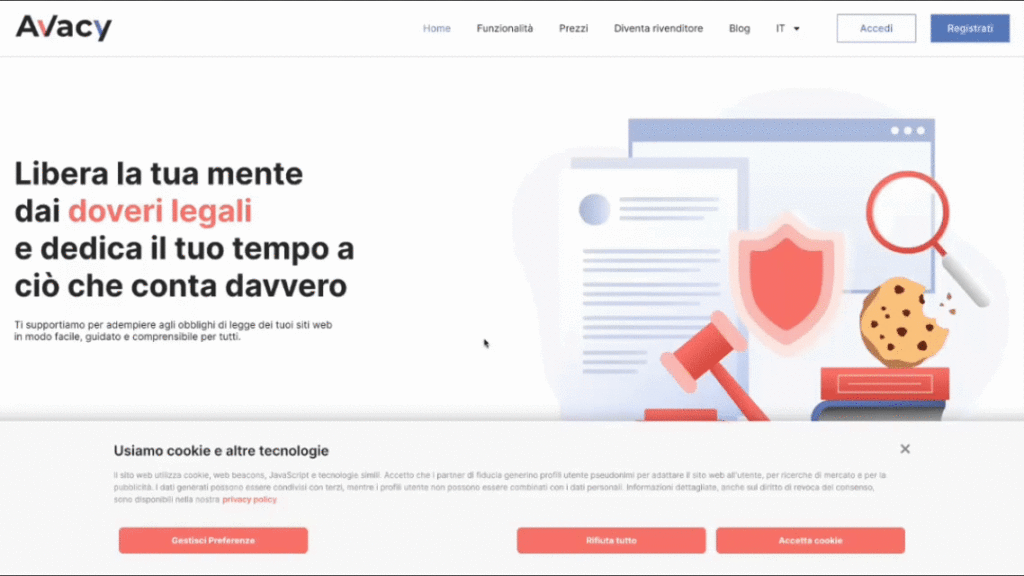Ah, cookies! Those little text files that make our online experience smoother and more personalized. But with growing concerns about privacy, managing cookie consent across different domains has become quite a headache. That’s where comes into play the Cross-Domain Cookie Consent. But is it actually allowed under privacy laws? And how can we implement it without losing our minds? Let’s find out together.
Consent for cross-domain cookies: what is it?

One of the fundamental aspects of personal data protection is obtaining users' informed consent for the collection and processing of their information.
Most privacy regulations, including the GDPR, state that without explicit consent for the use of cookies, websites cannot collect users’ personal data.
Moreover, under these regulations, every individual has the right to choose which information may be collected, used and shared by companies for commercial purposes.
The most common method for obtaining cookie consent is through a e-commercecookie banners, which is displayed to users on their first visit to a website.
If a company manages multiple websites with different domains or uses multiple subdomains, sharing consent across domains becomes a useful solution.
Cross-Domain Cookie Consent is the mechanism used to obtain a user’s consent regarding the use of cookies across multiple domains owned by the same entity or company.
This feature ensure that preferences are expressed only once for each instance owned by the platform, avoiding the need to accept or reject cookies every time they visit a related site. Without this option, users would be forced to repeat the consent process each time they navigate from one domain to another, which would negatively affect the user experience.
Therefore, cross-domain cookie consent makes it possible to show the cookie banner only during the initial visit and it will not appear again on subsequent visits to other related websites.
Website owners can, thus, save and store a user’s preferences across multiple linked domains. So, if cross-domain cookie consent is enabled, a user’s full acceptance or rejection of cookies will be applied to all related sites. However, if the user accepts only certain categories of cookies (e.g., functional cookies), the same choice will be maintained across all linked domains.
This is an especially important aspect to consider when configuring a cookie banner for multiple sites.
How does it work?
The Cross-Domain Cookie Consent works by having a primary domain collect the user’s consent through a banner displayed upon visiting the website. If the user accepts or rejects the use of cookies, their choice is saved in a cookie or in local storage.
This preference is then shared across the various websites owned by the same company, even if they belong to different domains, so that the user’s choice is respected without prompting for consent again.
Is synchronizing consent across domains allowed under privacy laws?
The short answer is: it depends. Privacy regulations, such as the GDPR in Europe, require that users give explicit consent before their data can be collected or shared.
If you manage multiple domains with identical cookie configurations and users have given explicit consent on one of them, it is possible to extend that consent to the other related domains. However, if your domains use different cookies - especially third-party ones - cross-domain consent may not be valid.
Moreover, rules vary from country to country: some privacy authorities require consent to be collected separately for each domain, while others accept shared consent as long as it is properly communicated to the user.
For this reason, it is essential to use a reliable Consent Management Platform (CMP) like Avacy, which can adapt to the various regulations in force.
Conditions for cross-domain cookie consent sharing from the user’s perspective
To ensure that cookie consent sharing across domains is both compliant with regulations and respectful of users, it is essential to follow these principles:
- Transparency: users must be clearly informed that their cookie consent will be applied across multiple related domains.
- Explicit consent: consent must be clear, informed and easily revocable at any time.
- Uniformity: the cookie configuration must be consistent across all involved domains, avoiding discrepancies that could confuse users or violate regulations.
- Security: the transmission of consent-related data must be secure, without exposing sensitive information.
If these requirements are not met, there is a risk of facing hefty fines and losing user trust.
How to enable cookie consent sharing across domains
Implementing the Cross-Domain Cookie Consent may seem complex, but by following these steps, the process becomes much more manageable:
- Use a reliable Consent Management Platform (CMP): solutions like Avacy simplify the collection of consent and allow for sharing across domains in full compliance with the GDPR and other privacy laws.
- Properly configure your domains: make sure all involved domains are set up to recognize and apply shared consent preferences.
- Implement a consent synchronization mechanism: a good CMP enables consent to be recorded on one domain and transmitted securely to the other related domains.
- Communicate clearly with users: in your cookie banner and privacy policy, inform users that their consent will apply across multiple related domains.
With an CMP like Avacy, all of this happens simply and effectively, without the need for complex technical setups.
Browser limitations in sharing cookies across domains
Modern browsers like Safari and Firefox block third-party cookies by default. This behavior makes it impossible to share consent when operating across different domains (cross-domain) using cookies, if a user provides consent on one domain but then visits another domain (even if owned by the same entity), the consent banner will be displayed again.
Is there a workaround? There are no truly effective or regulation-compliant workarounds to bypass this limitation. Solutions like using local storage or other client-side mechanisms do not solve the cross-domain sharing issue, as they are subject to the same limitations and do not allow direct communication between isolated domains.
The only currently valid strategy is to manage consent separately for each domain, while ensuring that the user experience remains clear and consistent. Platforms like Avacy simplify this separate management, ensuring that each domain has its own consent lifecycle, always up to date with the latest regulations.
Avacy: the effective solution for Cross-Domain Cookie Consent
If you’re looking for a reliable Consent Management Platform (CMP), Avacy is the perfect solution for you.
- Cross-domain consent management: one single consent request for all your domains.
- Full compliance: Avacy automatically adapts to the privacy regulations of each country.
- Advanced customization: configure the cookie banner exactly how you want, without losing users due to overly aggressive settings.
- Detailed analytics and reports: track who accepts or rejects cookies and optimize your strategy.
- Easy to implement: no technical knowledge required - Avacy integrates with just a few clicks.
Conclusion: consent shouldn’t be an obstacle
Managing cookie consent across multiple domains is not just a legal requirement - it’s also an opportunity to enhance the user experience and optimize data collection.
Proper synchronization of cookies across domains and subdomains helps avoid legal issues, reduces cookie rejection rates and provides a smooth, transparent user experience.
With Avacy, you can manage consent effectively, securely and in full compliance with regulations.
Want to simplify cookie management across your domains? Try Avacy and take your compliance to the next level!






